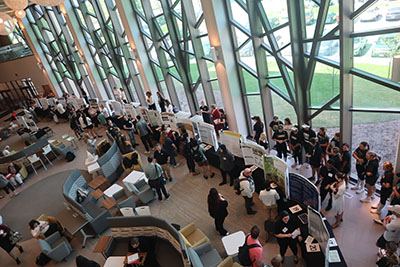The Tanuki Afterimage Illusion
Student Type
Undergraduate
Faculty Sponsor
Sara Bagley
Date
4-12-2022
College Affiliation
College of Science, Technology, and Health
Department
Psychology
Submission Type
Oral Presentation
Abstract
As part of the Sensation and Perception course, we formed a team and came up with an illusion from scratch. For our illusion, we decided to create an afterimage with the shape of a raccoon. Tanukis were raccoon-like Japanese legendary creatures famous for their antics and trickery. As the folklore goes, they were shapeshifters and masterminds of deception. Keeping this in mind, we decided our illusion would hold congruence with the Tanuki´s mischievous nature. Thus, our rationale behind deciding for an afterimage illusion. Negative images are designed to exhaust the eyes’ cone cells, forcing the non-fatigued cones to inform the brain of a present color when the image is removed from sight, creating the afterimage illusion. Our illusion illustrates the many Gestalt Principles, including closure and good continuation. The outlines are filled in by how the brain sees an image. In the case of our illusion, the image is not completely closed and is instead made of different colored dots.
Recommended Citation
De Gregorio, Diego; Peterson, Morgan; Self, Amanda; and Tayloe, Paige, "The Tanuki Afterimage Illusion" (2022). 2022 Student Academic Showcase. 1.
https://digitalcommons.lindenwood.edu/src/Oral_Presentations/Session2/1
Publication Date
2022
The Tanuki Afterimage Illusion
As part of the Sensation and Perception course, we formed a team and came up with an illusion from scratch. For our illusion, we decided to create an afterimage with the shape of a raccoon. Tanukis were raccoon-like Japanese legendary creatures famous for their antics and trickery. As the folklore goes, they were shapeshifters and masterminds of deception. Keeping this in mind, we decided our illusion would hold congruence with the Tanuki´s mischievous nature. Thus, our rationale behind deciding for an afterimage illusion. Negative images are designed to exhaust the eyes’ cone cells, forcing the non-fatigued cones to inform the brain of a present color when the image is removed from sight, creating the afterimage illusion. Our illusion illustrates the many Gestalt Principles, including closure and good continuation. The outlines are filled in by how the brain sees an image. In the case of our illusion, the image is not completely closed and is instead made of different colored dots.


